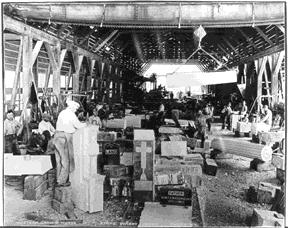
Index quarry once a bulwark of local economy...
© by Louise Lindgren
It's called "The Wall" by rock climbers - a thousand foot cliff of solid granite m the foothills of the Cascade mountaius just west of the Town of Index. It may have seemed like the wall to a Swede named John Soderberg who, in 1904, came prepared to cut and blast a fortune out of the stone. He was an entrepreneur, trained in granite work, and would add another major quarry to his long list of business enterprises.
Every year hundreds of climbers clamber up one of many routes to the top of The Wall. One of the easiest to follow makes use of the cracks in an "open book" formation. It's called the "bolt route" and invanably surprises each climber in turn who discovers that there really is a boIt" at the top.
An iron ring, perhaps an inch thick and six inches across, protrudes from the solid rock, perplexing the beholders unfamiliar with the history of the place. One such climber, also a sculptor of stone, was intrigued.
His name was Jim Acord and he settled for a time in the area, to study as well as climb the rock. Returning in 1978, after several years of apprenticeship at the granite "capital" of the world, Barre, Vermont, he agreed to speak with the Index Historical Society about the "treasure"in their own back yard.
The people of Index had long Imown that Western Granite Works started by John Soderberg was a bulwark of the local economy during the tens and twenties. Their historian, Ruth Burgstabler, had written that the business employed up to 75 men at its height.
There were also the stories of the many constructions up and down the Pacific coast that boastod foundations of Index granite. Even the steps of the State Capitol came from the cliff. Then, there were the miles of roadways, paved and curbed with granite before the days of concrete and blacktop.
Still, in typical small-town fashion, most people in 1978 were unaware of the stature of the quarry in relation to its counterparts across the country. Acord set them straight. "I say clearly, that the Index granite manufacturing was one of the most thorough producing areas in the United States."
He spoke of the method of blasting, a "soft cushion" technique by which evenly spaced blasting holes are filled with a slow-burning black powder so the rock is not shattered but rather 'lilfed up and cushioned." The method was clear in a series of photos taken of the 'big blast" in the very area of the present climbers' bolt route;" the blast that tore the rock from the wall, leaving that "open book" effect.
The resulting blocks of granite were made into everything from foot-long paving stones, to finely fluted "temple" columns for installation in the finest downtown buildings.
So, Soderberg's "Western Granite Works" of Index closed its complex operation. The man died in 1935, having lived an adventurous lffe as a businessman, land owner, granite expert, founder of Swedish Hospital, and all-round entrepreneur. From his office in Seattle's Alaska Building he had managed business ventures stretching from Alaska and down the Pacific Coast to points east.
Recently, his son visited Index and spent an afternoon reminiscing about his father and their business visits to Index. He added more edirices to the list of known Index granite constructions: Seattle's Frederick and Nelson building and both the Great Northern and Union stations as well as the Navy?s drydock in Bremerton. The stories he told will make another column.
Acord would have been impressed, but as an artist of the stone, might not have taken the elder Soderberg's advice seriously: "Son, don't get into the granite business - it never wears out!"
Another specialty was tombstones and monuments. Soderberg imported costly pink and black granite to augment the nonnal "salt and pepper" color of native stone. One prize piece from that era is a perfect sphere of black Swedish granite, polished to a high sheen.
According to Acord, the sphere was the hardest of all to make. "The equipment necessary to produce spheres is the most sophisticated in the industry." The stone had to be tumbled in an abrasive slurry within two hemispherical forms until the round shape emerged.
No, Soderberg didn't stint on the Index quarry. It was one of the finest examples of such an operation in the nation. Why its' demise? Concrete. And, the Great Depression. Index was not alone. According to Acord, most of the major hard-rock quarry operations in the country dosed down between 1928 and 1932.
Foundations for buildings began to be made by relatively unskilled workers using poured concrete forms. The cost for granite cutters, who apprenticed four to six years in order to cut stone within an eighth of an inch of perfection, could not compete with the new technology. Roadways too, were using concrete, eliminating the need for paving stones.
Louise Lindgren is a cultural projects coordinator, exhibits designer, and freelance writer.
![]()
This web page is hosted by Mamoun Sakkal AIA,
architect